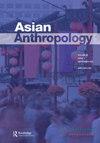Bodies in place: the transformative atmospherics of lightscapes in Mahikari
Q2 Social Sciences
引用次数: 1
Abstract
Abstract Practice centers (dojos) in the Japanese new religion Mahikari are perceived to be spaces suffused with divine light. This article examines this understanding in terms of the enactment of a particular kind of atmosphere – a lightscape – which is deemed to be capable of automatically producing transformative effects. As a key ethnographic example of this idea of atmospheric effects, I consider the case of the primary training course, participation in which is the means of entry into Mahikari. Although the course itself appears to be didactic in design, I suggest that, as an event, a different dynamic is at work, in which the major aim is less about the transmission of information than it is about the elicitation of transformation, a change which is understood to be largely a consequence of the atmospheric conditions in the dojo.身体就位:Mahikari灯光景观的变革氛围
日本新宗教Mahikari的修行中心(道场)被认为是充满神圣光芒的空间。这篇文章从一种特殊氛围的营造角度来审视这种理解——一种被认为能够自动产生变革效果的灯光景观。作为这种大气影响思想的一个重要民族志例子,我认为初级培训课程是进入Mahikari的途径。尽管课程本身在设计上似乎是说教性的,但我认为,作为一个事件,一种不同的动态正在发挥作用,其中的主要目的与其说是信息的传递,不如说是引发转变,人们认为这种变化很大程度上是道场大气条件的结果。
本文章由计算机程序翻译,如有差异,请以英文原文为准。
求助全文
约1分钟内获得全文
求助全文
来源期刊

Asian anthropology
Social Sciences-Anthropology
CiteScore
1.60
自引率
0.00%
发文量
25
期刊介绍:
Asian Anthropology seeks to bring interesting and exciting new anthropological research on Asia to a global audience. Until recently, anthropologists writing on a range of Asian topics in English but seeking a global audience have had to depend largely on Western-based journals to publish their works. Given the increasing number of indigenous anthropologists and anthropologists based in Asia, as well as the increasing interest in Asia among anthropologists everywhere, it is important to have an anthropology journal that is refereed on a global basis but that is editorially Asian-based. Asian Anthropology is editorially based in Hong Kong, Taiwan, and Japan, but welcomes contributions from anthropologists and anthropology-related scholars throughout the world with an interest in Asia, especially East Asia as well as Southeast and South Asia. While the language of the journal is English, we also seek original works translated into English, which will facilitate greater participation and scholarly exchange. The journal will provide a forum for anthropologists working on Asia, in the broadest sense of the term "Asia". We seek your general support through submissions, subscriptions, and comments.
 求助内容:
求助内容: 应助结果提醒方式:
应助结果提醒方式:


